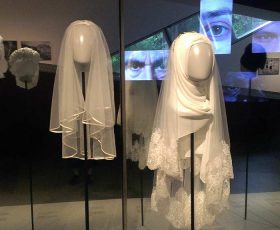The Italian Writer Elena Loewenthal Reflects on Strong Jewish Women in the Torah
The current exhibition Cherchez la Femme, which explores religious dress codes for women from women’s perspectives, remains on display until 27 August (more about the exhibition on our website). When I first found out the exhibition’s theme, I immediately thought of the novel Attese (2004) by the Italian author Elena Loewenthal. (The title means either “expectations” or “times of waiting.”) In four extended sections, the novel tells the stories of different Jewish female characters throughout the ages. But the novel’s real main character is a mysterious veil that follows the protagonists from Biblical times to modern-day Venice.

Veils in the exhibition Cherchez la femme; Jewish Museum Berlin, photo: Mirjam Bitter
We can read the veil as a metaphorical vessel of Jewish memory that women have guarded and passed on, a vessel that embodies recollection and forgetting, tradition and renewal. Indeed, the reasons each woman in the novel dons the veil are not only cultural (such as marking mourning) but personal: each of them reshapes it, sews in her own threads, or at least cultivates an idiosyncratic relationship with the garment she inherited. → continue reading
The Many Faces of Isaac and Ismael, Part 4
Our special exhibition, “Obedience. An Installation in 15 Rooms by Saskia Boddeke & Peter Greenaway,” has been extended until 15 November 2015. The multimedia art installation takes on the sons’ perspectives of this biblical story, when Abraham intended to sacrifice his son in fulfillment of God’s command. In a film projection at the beginning of the exhibition, visitors are greeted by children, youth and young adults with the words, “I am Isaac” or “I am Ismael,” in a variety of languages.
There’s an interactive component to the exhibition, located in the Eric F. Ross Gallery on the ground floor of the Libeskind Building: A video box where visitors can express these words in their own way and, in so doing, more strongly identify with the child perspective of this story of the attempted sacrifice. We’ve presented a small selection of these video clips on the blog over the last several months.
Lisa Albrecht, continuing her task of compiling the clips, has concluded that Isaac and Ismael not only have many faces, but also many names.
However, not all Museum guests are so ‘obedient’ in fulfilling the video box’s intended purpose: → continue reading
The Many Faces of Isaac and Ismael, Part 3
Everyday, hundreds of video clips get produced at our video box that is part of the exhibition “Obedience. An Installation in 15 Rooms by Saskia Boddeke & Peter Greenaway.” This month, we have been particularly taken by the multitude of languages spoken by our visitors who present themselves as Isaac or Ismael:
Lisa Albrecht, responsible for compiling the clips, is since able to introduce herself in a number of languages.
